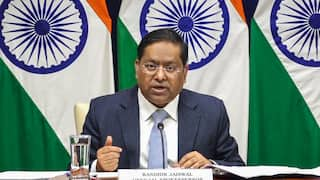Chemistry Nobel Laureate John Goodenough, Who Pioneered Lithium-Ion Battery Development, Passes Away At 100
John B Goodenough was awarded the 2019 Nobel Prize in Chemistry for his contributions to the development of the lithium-ion battery, along with M Stanley Whittingham and Akira Yoshino.

John Bannister Goodenough, an American scientist who pioneered the development of the lithium-ion battery, has passed away at the age of 100, The University of Texas at Austin announced Monday. He had been a professor at the university since 1986, and was also a public servant. He was awarded the 2019 Nobel Prize in Chemistry for his contributions to the development of the lithium-ion battery, along with M Stanley Whittingham and Akira Yoshino.
It is because of lithium-ion batteries that the wireless revolution occurred, leading to the development of a wide array of electronic devices. In 2019, Goodenough became the oldest person to win a Nobel Prize.
Goodenough’s education and research
He was born to American parents in Jena, Germany, and studied mathematics at Yale University. During the Second World War, he served as a meteorologist in the US Army.
After this, Goodenough studied at the University of Chicago, and received a doctorate in physics there in 1952, the Nobel Prize Organisation says on its website.
Goodenough studied under Nobel laureate Enrico Fermi and John Simpson at the University of Chicago. Both Fermi and Simpson worked on the Manhattan Project.
The American chemist had worked at the Massachusetts Institute of Technology (MIT) and Oxford University in Great Britain. He worked at MIT's Lincoln Laboratory for 24 years, laying the groundwork for the development of random-access memory for the digital computer.
Goodenough was one of the founders of the modern theory of magnetism, and conducted important research in orbital physics.
Goodenough’s work on the lithium-ion battery
While working at the Inorganic Chemistry Laboratory at the University of Oxford, Goodenough made the lithium-ion discovery.
For 37 years, Goodenough served as a faculty member at the Cockrell School of Engineering, The University of Texas at Austin. He held faculty positions in the departments of mechanical engineering, electrical engineering and computer engineering. During his tenure at The University of Texas at Austin, he conducted extensive research on battery materials, and conducted experiments to address fundamental science and engineering problems to create the next generation of rechargeable batteries.
Lithium is an element which willingly releases electrons, and hence, is useful in making batteries, which store electrical energy and are crucial to meeting the world's energy demands.
ALSO READ | Physics Nobel 2022: The Mysteries Of Quantum Entanglement, And Their Relevance For The Future
Goodenough developed a lithium battery in 1979. He used a cathode of cobalt oxide, which can house lithium ions because it has spaces at the molecular level. The cathode was highly effective because it provided a higher voltage than earlier batteries.
Goodenough and his team found in 1979 that by using lithium cobalt oxide as the cathode of a lithium-ion rechargeable battery, it would be possible to achieve a high density of stored energy with an anode other than metallic lithium.
According to The University of Texas at Austin, the critical cathode materials developed by Goodenough for lithium-ion batteries provided the high-energy density needed to power electronic devices such as mobile phones, laptops and tablets, and electric and hybrid vehicles.
ALSO READ | Ice Cream Therapy, Constipated Scorpions, Blind Dates — Studies That Won Researchers 2022 Ig Nobel
Sony Corporation commercialised the lithium-ion battery in 1991. Goodenough had provided the foundation for a prototype of the lithium-ion battery. A safer and more environmentally-friendly cathode material was discovered in his research group in 1996. A Canadian hydroelectric power company acquired the patents for this environmentally-friendly battery in 2020.
Lithium-ion batteries have since been used in mobile phones and electric cars.






































